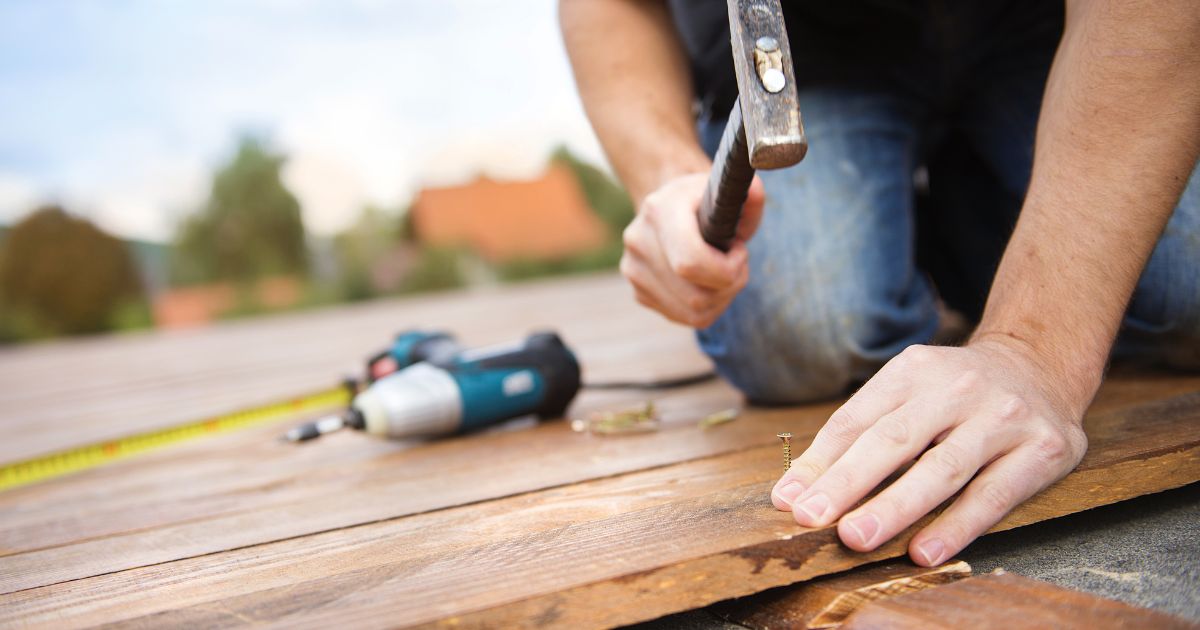When installing wood floors, achieving a flawless and seamless finish is often the ultimate goal. But, while nails are a common method of securing wood flooring, visible nail heads can detract from the aesthetic appeal. That’s where the art of concealing wood floor nails comes into play.
In this blog post, we will explore tips and tricks to help you achieve a seamless finish by concealing the nails used in wood floor installation. Also, we will delve into different techniques and approaches that can make your wood floors look pristine without any nail heads disrupting the surface.
From choosing the right type of nails to employing smart installation techniques, we will guide you through concealing wood floor nails. Whether you are a DIY enthusiast or a professional flooring installer, this blog post will provide valuable insights and practical advice to achieve that desired flawless finish.
Get ready to discover the trade secrets as we delve into concealing wood floor nails. By the end of this blog post, you’ll have a comprehensive understanding of the techniques and tools required to achieve a seamless appearance, elevating the aesthetic appeal of your wood floors. So let’s dive in and unlock the secrets to a concealed wood floor!
“Nail Disappearing Act: Concealing Wood Floor Nails with Finesse”
Have you ever marvelled at the beauty of a installed wood floor, where every plank flows into the next, free from any visible signs of nails? Unfortunately, achieving such a flawless finish is no magic trick but an art form known as the “Nail Disappearing Act.” This blog post will delve into the techniques and strategies required to conceal wood floor nails with finesse, creating a smooth and seamless surface that captivates the eye. From selecting the right nails and mastering proper placement techniques to using nail sets and countersinks, we will unlock the secrets to achieving a disappearing act for those nail heads. With tips on choosing the right wood filler, applying it , and blending the finish , your wood floors will appear as if they were untouched by nails. Join us as we unveil the secrets behind the Nail Disappearing Act, and elevate your wood floor installation to perfection.
“Unveiling Perfection: Tips for Concealing Wood Floor Nails”
When it comes to wood floor installation, achieving perfection is the ultimate goal. Every detail matters, including the proper concealment of wood floor nails. In this blog post, we will unveil a treasure trove of tips and techniques for concealing wood floor nails , allowing the true beauty of your floors to shine through. We will explore the importance of selecting the right nails and delve into the art of precise nail placement. Discover how to use nail sets and countersinks to ensure a flush finish, and learn about the best wood fillers to cover those nail holes . From the crucial steps of applying wood filler and sanding to the final touches of staining and finishing, we will guide you through each stage. So get ready to elevate your wood floor installation as we unveil the secrets and tips for concealing wood floor nails with finesse. Say goodbye to unsightly nail heads and hello to a finished floor that will leave everyone in awe.
“Secrets of Concealment: Unlocking the Art of Hiding Wood Floor Nails”
In the world of wood floor installation, there exists a hidden art, a secret known only to skilled craftsmen—the art of hiding wood floor nails. This blog post will unlock the secrets of concealment, revealing the techniques and strategies to achieve a seamless finish. We will delve into the intricacies of selecting the right nails, exploring the nuances of size, material, and design. From expert nail placement to using specialized tools like nail sets and countersinks, we will guide you through achieving the perfect hidden finish. But that’s not all—we will uncover the magic of wood fillers, sharing tips on color matching, application, and sanding for an invisible result. Join us as we journey into hidden artistry and unlock the secrets of concealing wood floor nails, transforming your floors into masterpieces that will leave others wondering, “Where are the nails?”
Selecting the Right Nails
Selecting the right nails for your wood floor installation is crucial in achieving a seamless and durable finish. Several types of nails are available, each suitable for different wood floor installation techniques. Common options include flooring nails, finishing nails, and cleat nails. When choosing nails for concealment, there are a few important factors to consider.

Types of Nails Suitable for Wood Floor Installation
Nail size is crucial as it should be appropriate for the thickness of the wood flooring material to ensure proper holding power without causing splits or cracks. Additionally, the nail head design is essential for achieving effective concealment. A smaller nail head, such as a headless or countersunk design, makes hiding the nail beneath the surface easier.
Factors to Consider When Choosing Nails for Concealment Purposes
The material of the nail should be chosen carefully, considering the type of wood flooring and any potential compatibility issues. By considering these factors and selecting the right nails for concealment, you can set a solid foundation for achieving a flawless finish in your wood floor installation project.
Applying Wood Filler and Sanding
Applying wood filler and sanding are crucial in concealing wood floor nails and achieving a flawless, seamless finish. It’s important to start with a clean and dry surface when filling nail holes with wood filler. Choose a high-quality wood filler that closely matches the color of your wood flooring. Then, using a putty knife or a similar tool, carefully fill the nail holes with the wood filler, ensuring they are filled and levelled with the surrounding surface. Allow the filler to dry thoroughly as per the manufacturer’s instructions. Once dry, it’s time to move on to the sanding process. Begin with a coarse-grit sandpaper to level the filled areas with the rest of the floor, using smooth and even strokes. Gradually progress to finer-grit sandpaper, refining the surface and smoothing any imperfections. Be sure to sand in the direction of the wood grain to achieve a uniform appearance. Regularly clean the surface during sanding to remove dust and debris, allowing you to assess your progress and ensure a smooth and consistent finish. You can achieve a beautifully concealed wood floor with a seamless and polished look by carefully applying wood filler and employing proper sanding techniques.
Step-by-step Instructions For Filling Nail Holes With Wood Filler
Here’s a more detailed breakdown of the step-by-step instructions for filling nail holes with wood filler:
Clean The Surface
Choose The Right Wood Filler
Prepare The Filler
Apply The Filler
Remove Excess Filler
Let It Dry
Sand The Filled Areas
Clean and Inspect
Proper Sanding Techniques to Achieve a Smooth, Levelled Surface
Proper sanding techniques are essential to achieve a smooth and levelled surface when concealing wood floor nails. Start by ensuring you have the right sandpaper grit for the job. Begin with a coarser grit to remove any unevenness or high spots in the filled nail holes and surrounding areas. Use a back-and-forth or circular motion, working toward the wood grain. As you progress, gradually switch to finer grits to refine the surface, smoothing any remaining imperfections. Be mindful of applying even pressure and avoiding excessive force, as this can result in uneven sanding or damage to the wood. Regularly clean the sanded surface to remove dust and debris, allowing you to assess your progress and make any necessary adjustments. Remember to feather the edges of the filled areas to blend them with the surrounding wood, creating a visually seamless result. By following proper sanding techniques, you’ll achieve a smooth, levelled surface that enhances the overall appearance of your wood floor while ensuring a flawless finish.
Staining and Finishing Considerations
Staining and finishing considerations are vital in achieving a seamless and cohesive look for your wood floor after concealing the nails. Selecting a stain colour that complements the wood species and matches the surrounding floor is crucial for staining. Test the stain on a small, inconspicuous area first to ensure it achieves the desired color and blends well with the filled nail holes. Next, apply the stain evenly and follow the manufacturer’s instructions for drying time and additional coats, if necessary. Once the stain is dry, apply a protective finish, such as polyurethane or varnish, to enhance the durability and beauty of the wood floor. Choose a finish that suits your preferences, whether glossy, semi-gloss, or matte sheen. Finally, apply the finish with smooth, even strokes, following the wood grain, and allow sufficient drying time between coats. Properly finishing the wood floor provides protection and ensures a uniform appearance that seamlessly integrates the concealed nail holes into the overall aesthetics. By considering staining and finishing considerations, you can achieve a stunning result that showcases the beauty of your wood floor while maintaining a flawless finish.
Maintenance and Care Tips
Proper maintenance and care of wood floor nails are crucial for preserving your wood floors’ seamless finish and longevity. Here are some essential tips to keep in mind. First, regularly clean your floors using a soft broom, vacuum with a soft brush attachment, or a damp mop. This helps prevent the accumulation of dirt, dust, and debris that could damage the concealed nail holes or scratch the surface. Avoid harsh or abrasive cleaning agents that strip the finish away or discolour the wood. Finally, consider using rugs or mats to protect the floor and reduce wear on the concealed nail holes in high-traffic areas.

Additionally, be cautious when moving heavy furniture or appliances to prevent them from scratching or denting the floor, potentially revealing the nails. If you notice any damage or wear on the concealed nail holes, promptly fill and refinish the affected areas. Finally, regularly inspect your floors for any signs of wear, such as loose boards or raised nails, and address them promptly to prevent further damage. By following these maintenance and care tips, you can ensure your wood floors’ longevity and pristine appearance, preserving the seamless finish achieved through the art of concealing wood floor nails.
Conclusions
Mastering the art of concealing wood floor nails requires attention to detail and implementing effective tips and tricks. Every step is crucial in achieving a seamless finish, from selecting the right nails to applying wood filler and utilizing proper sanding techniques. Staining and finishing considerations and regular maintenance are essential for preserving the pristine appearance of the concealed nail holes.

